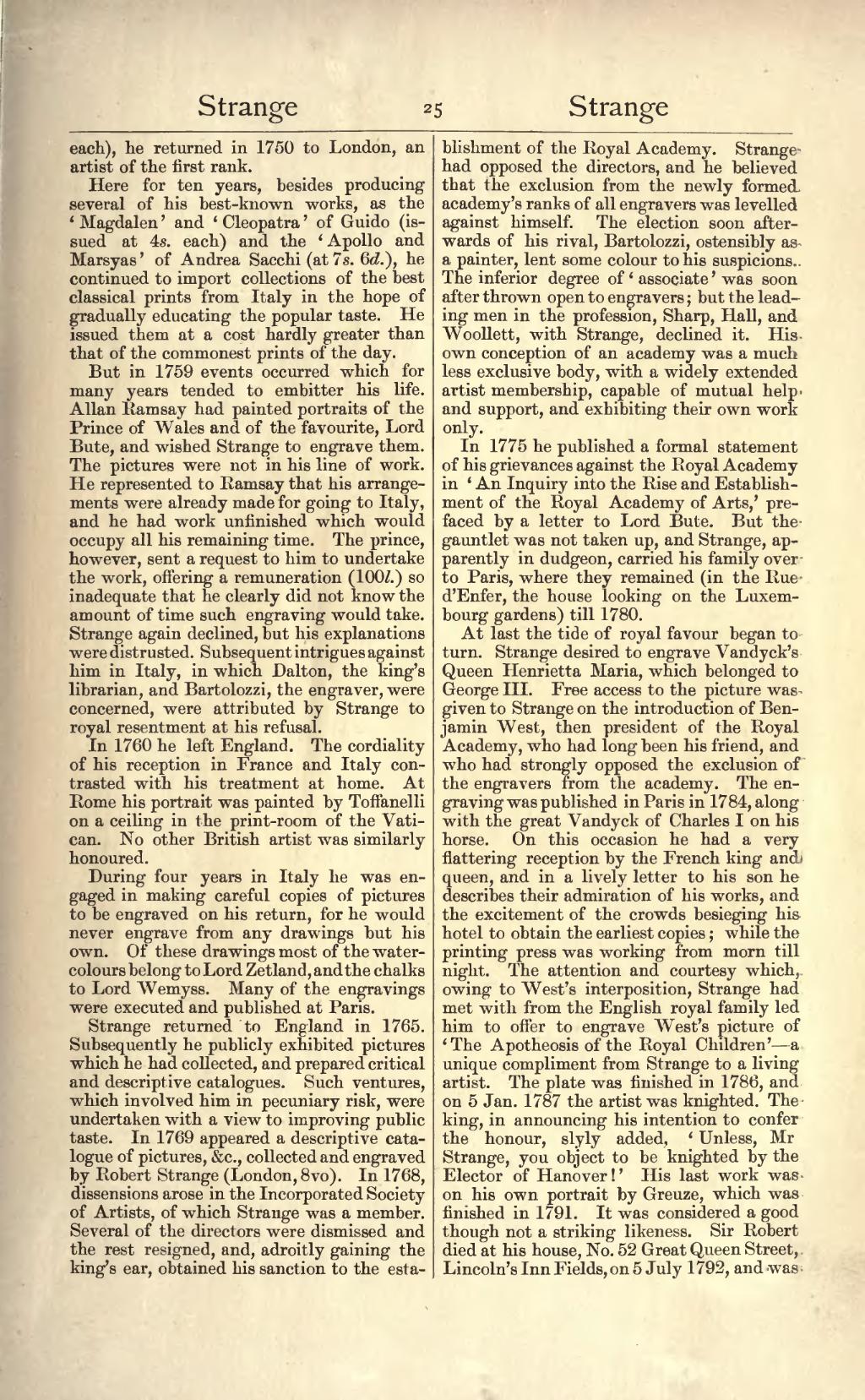each), he returned in 1750 to London, an artist of the first rank.
Here for ten years, besides producing several of his best-known works, as the ‘Magdalen’ and ‘Cleopatra’ of Guido (issued at 4s. each) and the ‘Apollo and Marsyas’ of Andrea Sacchi (at 7s. 6d.), he continued to import collections of the best classical prints from Italy in the hope of gradually educating the popular taste. He issued them at a cost hardly greater than that of the commonest prints of the day.
But in 1759 events occurred which for many years tended to embitter his life. Allan Ramsay had painted portraits of the Prince of Wales and of the favourite, Lord Bute, and wished Strange to engrave them. The pictures were not in his line of work. He represented to Ramsay that his arrangements were already made for going to Italy, and he had work unfinished which would occupy all his remaining time. The prince, however, sent a request to him to undertake the work, offering a remuneration (100l.) so inadequate that he clearly did not know the amount of time such engraving would take. Strange again declined, but his explanations were distrusted. Subsequent intrigues against him in Italy, in which Dalton, the king's librarian, and Bartolozzi, the engraver, were concerned, were attributed by Strange to royal resentment at his refusal.
In 1760 he left England. The cordiality of his reception in France and Italy contrasted with his treatment at home. At Rome his portrait was painted by Toffanelli on a ceiling in the print-room of the Vatican. No other British artist was similarly honoured.
During four years in Italy he was engaged in making careful copies of pictures to be engraved on his return, for he would never engrave from any drawings but his own. Of these drawings most of the water-colours belong to Lord Zetland, and the chalks to Lord Wemyss. Many of the engravings were executed and published at Paris.
Strange returned to England in 1765. Subsequently he publicly exhibited pictures which he had collected, and prepared critical and descriptive catalogues. Such ventures, which involved him in pecuniary risk, were undertaken with a view to improving public taste. In 1769 appeared a descriptive catalogue of pictures, &c., collected and engraved by Robert Strange (London, 8vo). In 1768, dissensions arose in the Incorporated Society of Artists, of which Strange was a member. Several of the directors were dismissed and the rest resigned, and, adroitly gaining the king's ear, obtained his sanction to the establishment of the Royal Academy. Strange had opposed the directors, and he believed that the exclusion from the newly formed academy's ranks of all engravers was levelled against himself. The election soon afterwards of his rival, Bartolozzi, ostensibly as a painter, lent some colour to his suspicions. The inferior degree of ‘associate’ was soon after thrown open to engravers; but the leading men in the profession, Sharp, Hall, and Woollett, with Strange, declined it. His own conception of an academy was a much less exclusive body, with a widely extended artist membership, capable of mutual help and support, and exhibiting their own work only.
In 1775 he published a formal statement of his grievances against the Royal Academy in ‘An Inquiry into the Rise and Establishment of the Royal Academy of Arts,’ prefaced by a letter to Lord Bute. But the gauntlet was not taken up, and Strange, apparently in dudgeon, carried his family over to Paris, where they remained (in the Rue d'Enfer, the house looking on the Luxembourg gardens) till 1780.
At last the tide of royal favour began to turn. Strange desired to engrave Vandyck's Queen Henrietta Maria, which belonged to George III. Free access to the picture was given to Strange on the introduction of Benjamin West, then president of the Royal Academy, who had long been his friend, and who had strongly opposed the exclusion of the engravers from the academy. The engraving was published in Paris in 1784, along with the great Vandyck of Charles I on his horse. On this occasion he had a very flattering reception by the French king and queen, and in a lively letter to his son he describes their admiration of his works, and the excitement of the crowds besieging his hotel to obtain the earliest copies; while the printing press was working from morn till night. The attention and courtesy which, owing to West's interposition, Strange had met with from the English royal family led him to offer to engrave West's picture of ‘The Apotheosis of the Royal Children’—a unique compliment from Strange to a living artist. The plate was finished in 1786, and on 5 Jan. 1787 the artist was knighted. The king, in announcing his intention to confer the honour, slyly added, ‘Unless, Mr. Strange, you object to be knighted by the Elector of Hanover!’ His last work was on his own portrait by Greuze, which was finished in 1791. It was considered a good though not a striking likeness. Sir Robert died at his house, No. 52 Great Queen Street, Lincoln's Inn Fields, on 5 July 1792, and was
